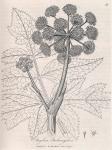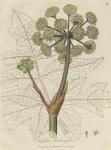
 Synonyma. Angelica. Pharm. Lond. & Edinb.
Synonyma. Angelica. Pharm. Lond. & Edinb.
Angelica sativa. Bauh. Pin. p. 155. J. Bauh. Hist. vol. iii. p. 140. Gerard. Emac. p. 999. Park. Theat. p. 939. Raii Hist. p. 434. Synop. p. 208.
Angelica foliis duplicato-pinnatis, ovato-lanceolatis serratis. Hal. Stirp. Helv. n. 807. Flor. Dan. t. 206.
Class Pentandria. Ord. Digynia. Lin. Gen. Plant. 138.
Ess. Gen. Ch. Fructus subrotundus, angulatus, solidus, stylis reflexis. Corollae aequales: petalis incurvatis.
Spec. Char. A. foliorum impari lobato.
The root is biennial, long, thick, and furnished with numerous fibres: the stalk is thick, strong, jointed, channelled, round, of a purplish colour, rises to the height of six or eight feet, and sends off several branches, which terminate in large umbels: the leaves are pinnated, large, numerous, confining of several pairs of oval, serrated, pointed, veined, irregular shaped lobes or pinnae, terminated by an odd one; the flowers grow in large terminal umbels, which are round, and composed of many radii: the corolla is small, white, and divided into five petals, which have their points turned inwards: the general involucrum consists of three or five narrow pointed leaves, the partial involucrum of five, and the calyx is cut into five minute segments; the five stamina are longer-than the petals, spreading, and furnished with roundish anthers: the germen is placed below the corolla, and supports two reflected styles, crowned with obtuse stigmata: the seeds are two, oval, flat on one side, convex on the other, and marked with three furrows.—It is a native of Lapland, ["Ubique peromnes alpes Lapponiae juxta rivulos vulgaris est." Lin. Flor. Lap, p. 67.] and flowers in June and August.
Angelica, as a native of a northern climate, seems to have been unknown to the ancients. It has been cultivated in Britain more than two centuries, [Cultivated in 1568. Turn. herb. part. 3. p. 5. Vide Hort. Kew.] and its medical character [We may also add its use in confectionary.] has rendered it of sufficient importance to be very generally propagated by the English gardener.—The roots of Angelica have a fragrant agreeable smell, and a bitterish pungent taste: on being chewed they are first sweetish, afterwards acrid, and leave a glowing heat in the mouth and fauces, which continues for some time. The stalk, leaves, and seeds, which are also directed in the Pharmacopoeias, appear to possess the same qualities, though in an inferior degree. It is said that "on wounding the fresh root early in the spring, it yields from the inner part of the bark an unctuous yellowish odorous juice, which gently exsiccated retains its fragrance, and proves an elegant aromatic gummy resin. On cutting the dry root longitudinally, the resinous matter, in which the virtue and flavour of Angelica resides, appears concreted in little veins." [Lewis Mat. Med. p. 59.] Rectified spirit extracts the whole of the virtues of the root; water but very little; and in distillation with the latter, a small portion of very pungent essential oil may be obtained.
We are told by Linnaeus, that the Laplanders entertain a high opinion of the utility of Angelica, and employ it both as food and as a medicine [Flor. Lap, a. c,]; and since Aromatic plants are rarely inhabitants of the Polar regions, their partiality for Angelica is extremely natural: and from the enumeration of the virtues of this plant by Bergius, [Virtus: alexiteria, slomachica, sudorifera, carminativa. It may be remarked that he says nothing of its usus. Mat. Med. p. 205. It was formerly recommended in female diseases. Mensibus lochiisque obstructis, partu difficili, suffocatione uteri; contra venena, & febres malignas.] we should also suspect him of being influenced by the same physical cause. Angelica must however be allowed to possess aromatic, and what are called carminative, powers, and is used accordingly in the tinctura aromatica of the Edinb. Pharm. but as many other simples surpass it in these qualities, it is seldom employed in the present practice.

